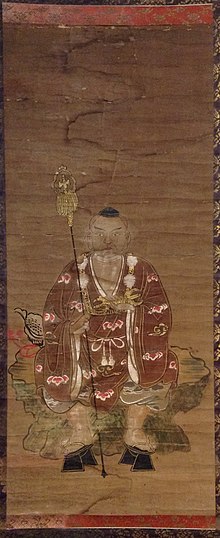Shōbō (monk)

Shōbō ( Japanese 聖 宝 ; born March 11, 832 on the island of Honjima ( Sanuki Province ); † August 29, 909 in Kyoto) was a Japanese monk of the early Heian period . He made a significant contribution to the expansion of the Buddhist Shingon school ( Shingon-shū ). The founding of the famous Daigo Temple ( Daigo-ji ) in Kyōto and the establishment of the Ono direction of Shingon Buddhism ( 真言 宗 小野 流 , Shingon-shū Ono-ryū ) go back to him. The syncretistic Shugendō also counts Shōbō to his ancestors. In 1707 he was given the honorary title Rigen Daishi ( 理 源 大師 , 'Great Teacher of the Principle Source') by Tennō Higashiyama .
Life
According to tradition, Shōbō was a sixth generation grandson of Tennō Tenchi and originally carried the name Tsunekage-ō ( 恒 蔭 王 , "Prince Tsunekage").
At the age of 16 he left home in 847 and was accepted by the Shingon monk Shinga ( 真 雅 , 801-879), a brother of Kūkai , as a student in the Tō Temple ( 東 寺 , Tō-ji ) in Kyoto. Here he was given the name Shōbō, roughly equivalent to 'holy treasure'. This was followed by further studies with monks from different schools such as Gangyō ( 願 曉 ), Enshū ( 円 宗 ) or Hyōnin ( 平 仁 ). In 871 he was introduced by Shinga into the Sutra of Unlimited Life ( Sukhāvatī-vyūha , 無量 寿 経 ), nine years later by Shinnen / Shinzen ( 真 然 ,? −891), a nephew of Kūkai, into the concepts of the 'diamond world' ( Vajradhātu , 金剛 界 , Kongōkai ) and the 'womb world' ( Garbhadhātu , 胎 蔵 界 , Taizōkai ) inaugurated. In 884 the long training ended with an Abhisheka initiation ritual ( 伝 法 灌頂 , Denbōkanjō ).
890 Shōbō took over the management of the Jōgan temple ( 貞 願 寺 , Jōgan-ji ) in Kyoto. With the support of Tennō Uda , he became the second head of the Tō Temple ( Tō-ji ) five years later , the most important temple of the Shingon School at the time. In 906 he took over its management. At the same time he was awarded the second highest priestly rank by the imperial court. When he fell ill in early 909, the Tennō Uda and Tennō Yōzei , who had resigned due to illness, visited him at the bedside. Shōbō died in the summer of the same year.
Merits
Shōbō achieved his greatest impact less through theological writings than through his religious practice. Kūkai was already drawn to the mountains, where he finally founded a temple ( Kōyasan ), in which great importance is still attached to the involvement of the local Shintō deities. Shōbō in turn felt a great affinity between the teachings of Shingon Buddhism and (according to tradition) going back to En no Gyōja Shugendō . To revive the ascetic exercises in the mountains and strengthen the Shugendō, he restored the dilapidated complex of the Kinpusen Temple ( Kimpusen-ji ) in Yoshino ( Nara Prefecture ) in 892 and made statues of Zaō Gongen ( 蔵 王 権 現 ), the most important Deity of the mountain ascetics ( Yamabushi ) of the Shugendō. In addition, he laid out retreat and pilgrimage routes and founded other smaller temples in the vicinity of Yoshino. Rigen Daishi is therefore one of the most important personalities in the history of Shugendo. In the immediate vicinity of the Hōkaku Temple ( 鳳閣 寺 , Hōkaku-ji ) on Mount Hyakkaidake ( 百 貝岳 ) south of Yoshino (Nara Prefecture) there is a memorial stone for Shōbō from the 14th century.
Shōbō is also known for the establishment of the Daigo Temple ( Daigo-ji ) on the summit of Mount Daigo in Fushimi (today the municipality of Kyoto ) . On inspiration, he first built a hall there to worship two Avalokitesvara statues. Thanks to the support of the Tennō Daigo (897–930), Suzaku (930–946) and Murakami (946–967), the complex soon gained impressive dimensions and became the main temple of the so-called Ono branch of the Shingon School ( Shingonshū Ono-ha ).
gallery
Zao Gongen Shrine in Katsuragi for the worship of Fudō Myōō , En no Gyōja and Shōbō alias Rigen Daishi
literature
- Shōbō-sō silk ( 聖 宝 僧 正 伝 , "Correct tradition to the monk Shōbō"), handwriting, Chinese. Written language. Digitized by the Imperial Court Office, Tokyo
- Saitō Ryūgen: Rigen Daishi jitsudenki . Kyōto: Fujii Bunseidō, 1908 ( 斎 藤 隆 現. 理 源 大師 実 伝 記. 藤井 藤 政 堂 ) Digitized by the National Diet Library Tokyo
Web links
References and comments
- ↑ In the Japanese calendar: 15th day, 2nd month, 9th year of the Tencho era
- ↑ Today part of the city of Marugame , Kagawa Prefecture
- ↑ In the Japanese calendar: 6th day, 7th Month, 9th year of the motto Enki
- ↑ More on this in the "Correct Tradition of the Monk Shōbō" ( Shōhō-sō silk )
- ↑ Originally, the group of figures was in a strapped shrine (jap. Oi ), which followers of Shugendō took to their exercises in the mountains.
| personal data | |
|---|---|
| SURNAME | Shobo |
| ALTERNATIVE NAMES | 聖 宝 (Japanese script); Tsunekage-ō (maiden name); 恒 蔭 王 (Japanese script); Rigen Daishi (honorary name); 理 源 大師 (Japanese script) |
| BRIEF DESCRIPTION | Japanese monk, founder of the Ono direction of Shingon Buddhism with great merit for the Shugendo |
| DATE OF BIRTH | March 11, 832 |
| PLACE OF BIRTH | Honjima (Sanuki Province), Japan |
| DATE OF DEATH | 29 August 909 |
| Place of death | Kyoto , Japan |


